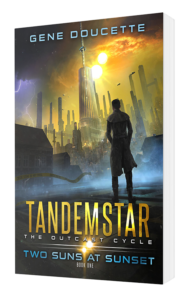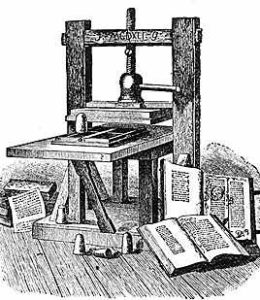All About Print Editions
I’m probably going to bore you today.
I want to talk a little about print editions, and I’m afraid that when I do so, I’m going to end up so far in the weeds that you’ll discover that I have bored you. Hopefully, this will be a surprise.
Anyway, you’ve been warned.
Now then. Let’s talk about print editions.
I’ve been doing this self-publishing thing for a little while now. In that time I have held one thing to be true: the vast majority of my sales are going to be digital in nature. At first, this was expressed entirely in ebook sales, but now I’m including audiobook sales as well. Print was always bringing up the rear, an incidental add-on for the occasional reader who insists on consuming my writing that way. (Please note that I say this as someone who gave up reading ebooks about four years ago. I greatly prefer print or audio.)
Here are some more things I have always held to be true. Some of them are no longer true, and it’s my own fault for not knowing this:
- The margins for print-on-demand (POD) publishing mean traditional publishing will always be able to price print books for less than I can, because they own the means of production and distribution;
- The only way to get a print book into brick-and-mortar bookstores is to traditionally publish, because bookstores have to be able to return unsold copies, and POD books can’t be returned, because they didn’t come from a warehouse and cannot be unprinted;
- Bookstores also expect to obtain copies at a 55% discount, which I do not have the means to provide them;
- Bookstores will also not work with Amazon to acquire print editions produced by Amazon, because…Amazon;
- The only way to get books into libraries is to be traditionally published as well; Amazon will not make print copies available to libraries, because Amazon is actively interested in killing libraries.
With all of that going on, it made sense to just use Amazon’s KDP Print option via the exact same dashboard I use to publish my ebooks, check off “expanded distribution” to pick up a stray print sale via an online merchant outside of the Amazon ecosystem, and call it a day. Since most sales are on Amazon anyway, how much of the market could I be missing?
Then Barnes & Noble decided to offer a print option as well, with the teaser that they might also be able to carry B&N Print editions in their stores, so I created a second edition for each of my books over there, and picked up a few more print sales from people shopping at the B&N website. (Have they carried any of my self-published books in their stores? Of course they haven’t.)
I was mostly fine with all of that. However, in September of 2018, I ended up with a traditionally published book of my own when The Spaceship Next Door got picked up, and then I wasn’t as okay about it. Why? Because readers who found TSND in a bookstore or a library couldn’t then discover any of my other books—not even the sequel to TSND—because I couldn’t get those other books into the stores or the libraries.
(I have another traditionally published title coming out in May of 2021—The Apocalypse Seven—and if I don’t do something about my existing titles, I’ll end up having failed to take advantage of my newfound exposure twice.)
IngramSpark
Flash forward a little, to a conversation I was having with an industry professional oh, around April of this year. She mentioned IngramSpark (IS), a company I have heard of, but didn’t know all that much about. She said the same thing I’ve heard elsewhere, i.e., it makes a lot more sense to use them for expanded print distribution than it does to use Amazon.
I never really asked why it made more sense; my sales from expanded distribution were pretty rough, so for the effort and cost involved in creating new editions at IS didn’t seem particularly cost-effective.
But then my friend mentioned that libraries can order books from Ingram, disproving #5 on my list.
So, when it came time to set up the print edition for Two Suns at Sunset, I decided to give it a try, with IS for one edition, an Amazon edition for the ‘zon-platform-only sales, and a Barnes & Noble edition for the B&N-platform-only sales.
In setting up the book, I made a number of surprising discoveries. First, I could allow for returns, disproving #2 on my list. Second, I could set it at a discount of up to the 55% industry standard, disproving #3 on my list. And, since IS is already not-Amazon, #4 on my list is irrelevant. The only thing that remained unchanged is the cost of producing an individual unit (#1) which is still a big deal, but not that big a deal.
I’d been thinking I could do this for all the books in the new Tandemstar line, but the longer I thought about it the more I realized I really should do it for my entire catalog.
ISBN problems
Something else that happened when I set up Two Suns at Sunset was that I bought an ISBN for the book.
I didn’t have to. IngramSpark has a free ISBN option, but it would be a number they would own. I was already familiar with how this worked, because I did the same thing at Amazon, for every single one of my print books. (This will come up again in about two paragraphs.)
After buying the ISBN for the IS-version of TSAS, I set up the Amazon edition using the same ISBN. Then I went to B&N and tried to do the same thing. B&N refused, and insisted I use a different number or use the one they also provide for free. (There is, I’m nearly positive, a good reason for this, but the reason I’ve been coming back to is “B&N is garbage.”)
By the way, ISBN stands for International Standard Book Number. Every published print book has to have one, and they’re not cheap unless you buy them in bulk. (This will come up again in about six paragraphs.)
Back to the idea of putting my entire catalog up on IngramSpark: you will recall that the existing editions all use an Amazon-owned ISBN. This means I can’t take them with me to another vendor and reuse them there. The only way to do that is to own the number myself.
Also, I can’t change the ISBN on a book that’s already published. Once it’s assigned, there’s no going back.
So what I could do, is publish an IS edition of each book using the free ISBN Ingram makes available, and continue to own none of my ISBNs. This isn’t the worst idea ever, especially since ISBNs cost money and it already costs $49 to set up a book at IS.
But then I still wouldn’t own the ISBN. I’d also have two listings for the same book on Amazon (which carries IngramSpark editions too) and two listings on B&N (for the same reason.)
Do I need to own my own ISBNs? Well, I don’t know. But back when I started doing this—when I was using Createspace, the predecessor of KDP Print—I didn’t think not owning my own ISBNs would be a problem, and now here I am with a problem.
So the other thing I could do is buy ISBNs in bulk. The cost to buy just one through IngramSpark is $85. The company that issues them is called Bowker, and the cost of buying just one from Bowker? is $125. But, you can also buy 10 from Bowker for $295. I need 12, so that won’t work either. Finally, Bowker offers a deal for 100 ISBNs for $595.
Not a bad deal.
But after that comes the thing about my not being able to transfer an already-published book from one ISBN to another, which is a problem for the existing catalog on Amazon. The only way to fix that…is to unpublished each title and then publish a new edition. Twelve times.
New Editions
That’s a lot of work and not a small amount of money. As I was ruminating on which option to go with (and discussing it with a couple of industry people) I realized that if I went all-in on this, I had an opportunity to really do new editions. Specifically, I could change the trim size.
Two Suns at Sunset will be my first title with a 5.25 x 8 trim size. (Side note: I did warn you about getting boring.) It’s the same dimensions as the publisher’s edition of The Spaceship Next Door, and I was already considering updating The Frequency of Aliens in order to match it, it being the sequel and all. Right now, all of the other titles are 6 x 9, which is a really popular size. In fact, if you’re holding a self-published print book, the odds are really good it’s 6 x 9.
Maybe I’m crazy—I probably am—but if that’s what I think when I hold a book that size, I can’t be the only one.
(Side note: if the publisher goes with a 6 x 9 trim size for The Apocalypse Seven, this part is going to look very silly.)
So why not go with a trim size I like, when I’m redoing the entire line anyway? It means adding another cost because those covers aren’t going to resize themselves, but if I’m doing all of the other things on this list, once it’s done I’m never going to have to do any of it ever again.
Anyway, I think that’s what I’m going to end up doing. It will be a pain the ass, and it will take a while to get everything set up properly (Amazon will have to combine lots of listings, and they are not the most proactive) and probably say goodbye to my B&N editions, but once it’s done maybe I’ll have everything ready to go by the end of May, 2021.
What do you think?
Join my mailing list, to receive my newsletter Writing from the border of Sorrow Falls. You can sign up from here.

While I’ve found that I prefer reading on my kindle anymore, I still love ‘dead tree’ versions of books, and a huge point there is you can’t get an ebook signed by the author. It does mean that for some of my favorite books I now have purchased two copies – one to read on my kindle (which also never gets beat up, dog eared or worn out!) and one to (hopefully) get signed.
Now the question is if you are ever coming to Ohio to sign my 1st edition of Immortal?
I might! If only because a first-edition Immortal is pretty rare